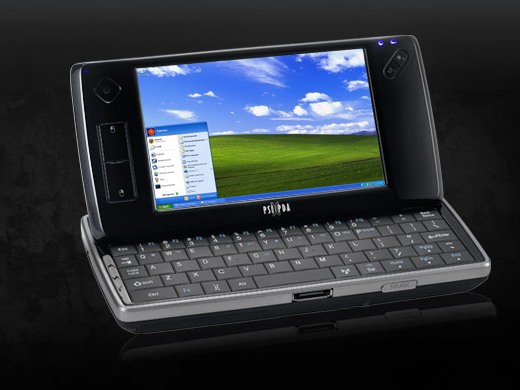Technical Informations
The Bikes, Navigation, GPS and Computers
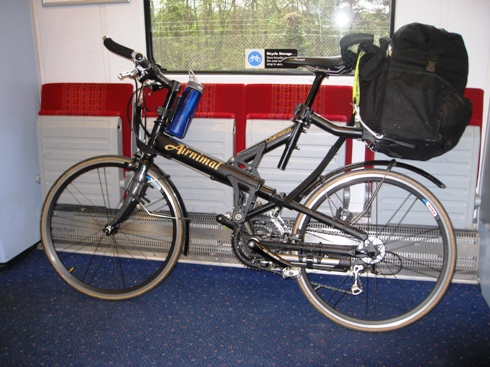
|
The Airnimal on the way to London |
The bikes - Ken's
I was a little concerned during the planning stages for this trip that I would not be able to keep up with John. He is after all several years my junior and by the time I joined him he had already been on the road for a month. So I was expecting him to be fitter than me.
I decided to use technology to try to overcome this problem. I needed a very lightweight bike which could be quickly dismantled to take on Eurostar and other trains. The Airnimal came to mind and research indicated that it would do the job.
Here a degree of self delusion set in. The fastest lightest nicest Airnimal is the Chameleon. It is a fast road bike and not the ideal choice for touring. I convinced myself that it would be alright if I cut my luggage down. I also assumed that the road surfaces we would experience would be no worse than those in Dorset. Both of these assumptions were substantially wrong.
The Chameleon with 20 spoke Velocity wheels weighs about 9 kilograms and my luggage about the same. I carried the luggage on a seat pin carrier modified by Stephen Parry to take a Brompton luggage block. I used the huge Brompton camper bag and a small Altura front bag. This set up works well but the luggage is too heavy for the bike, particularly on poorly surfaced roads and tracks.
I had no problem with Eurostar or the other European trains with the bike fully dismantled. It fits into a small holdall and wheel bag. The main problem I had was carrying 18 kiIograms of unwheeled luggage between trains. It takes about 15 minutes to dismantle or to reassemble the Chameleon. It is really only a job which should be carried out after quite a lot of practice at home.
Since returning I have ditched the ringo-star for a star fangled nut because it is easier to set up quickly and needs only one Allen key. Also when dismantled the parts can’t come off the steerer with the top washer on. I also plan to modify the Brompton bag to have two little wheels at the bottom and an extending luggage handle. Most other companies producing such an excellent bag would have done it themselves already. But then Brompton also take a similar approach to their main product lines or we would have a better Brompton bike so no hope for the bag.
On a future trip I would consider fitting a carrier, if I were feeling rich at the time a titanium Tubus Airy. The disadvantages are that it would increase the unsprung weight of the loaded bike and increase the time and complexity of dismantling and reassembling the bike. Airnimal would be more comfortable with this option. They are not very happy with the extra weight on the seat pin of the Brompton bag, though the total weight of the bag and me is within their specification of 225 lbs. They are also concerned that the Brompton bag could upset the downhill handling of the bike but I did not notice this and I tend to descend quickly.
I did go through two tyres on the tour, a Panracer with very minor sidewall damage and a Stelvio with serious damage near the rim. Both of these were caused by very bad road surfaces. The Panracer 25mm looked much smaller than the Stelvio 23mm. Ideally I would like to have used a smooth 28mm with a Kevlar belt but nothing like this is available for the wheel size and the choice of tyre is very limited.
I emailed Airnimal who rightly say that the bike I have, while being very fast, is not ideal for this type of touring. They would recommend the Airnimal Joey. Having said that I think the Chameleon coped very well and I very much like it and enjoyed riding it. I prefer taking little and relying on my credit card rather than carrying much more stuff and being self reliant. My main problem is to reduce the luggage enough, a problem I have not yet solved. If I can do this I will stick to the Chameleon at least for on road tours in first world countries. If someone would only produce some larger tyres I would also prefer it to the Joey on rougher roads.
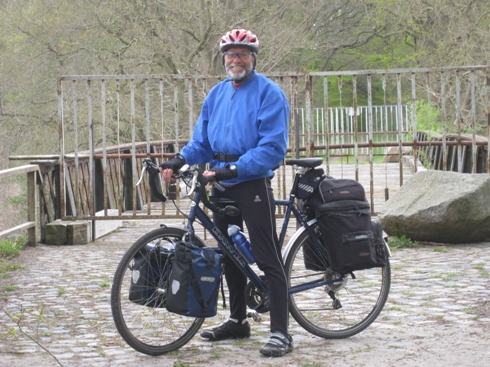 |
John with his loaded Dawes Horizon |
The bikes - John's
In many ways John's choice of bike, a mid range Dawes Horizon is just as unusual as mine for expedition touring. Perceived wisdom within the cycling community would be that he should take a bike with mountain bike sized wheels and equipped with a Rohloff 14 gear rear hub. Typically this would be a Thorn Nomad or similar costing in the region of £3000 ready to go rather than around £750 for John's bike.
John also went for the opposite end of the weight carrying options from me, taking camping gear. My guess is that his bike and equipment weighed in at around 30 kiIograms. It was hard to lift the back wheel off the ground.
Choosing a largely untested bike for expedition touring is a risk. It all depends on how good the factory designer was, the strength of the frame and forks, and the quality of the equipment specified. The problem with all these types of bikes is that the only way to find out how good they are is to take one on tour. All of the variables are impossible to determine in advance even between examples of the same model. Frame and fork strength is impossible to access and much of the basic equipment is from little known suppliers. For example, John had to replace the bottom bracket cassette before his tour started. This is a component which in my experience seldom fails.
As it turned out John's bike stood up to the tour very well. All the main components performed very well and much better than I would have expected. Surprisingly he had no spoke breakages and the wheels are still true. The rims are wearing well. Ideally he could now do with the wheels being checked by an expert wheel builder but they could easily do another 3000km without problem.
Tyres and carriers are areas where cycle tourists cannot afford to compromise. In my view John was lucky to get away with the tyres and carriers supplied with his bike. His tyres were from an unknown maker with a peculiar speed ridge down the centre. His carriers relied on heavy engineering rather than good design to survive. He would do well to get some Schwalbe Marathon tyres and Tubus carriers for future trips.
His luggage choice was interesting. He very sensibly used Ortlieb waterproof roll top classic panniers for everything he needed to keep dry. He carried these on the front carrier and as you would expect they performed faultlessly. His rear panniers were of the throw over kind connected in the middle. They are not waterproof and have long been out of fashion. They have the interesting and very useful feature of a small rucksack which is attached, I think by zips, to the top of the panniers. This can be quickly removed and used as a back pack for shopping and carrying valuables. I would guess his rear luggage will be in the bin years before the Ortliebs give up. On the other hand the rear luggage was not expensive and did the job John wanted them to do well.
Having travelled with John I do feel that the best option for expedition touring is the perceived wisdom of the cycling community. At least if you start with good quality reliable equipment there is less chance of things going wrong. The cost of the bike and equipment is not the major cost of an expedition of this type. Compromising on bike and equipment or even taking a risk on it being alright is just not worth it. Breakdowns are always very inconvenient and often expensive. The cost of replacing things like tyres and carriers to bring a bike up to a higher standard is also high. And that comes from somebody stupid enough to take an Airnimal Chameleon on tour on second world roads.
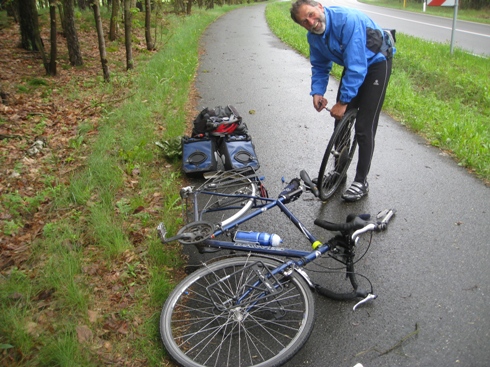
|
|
Breakdowns take time and can be expensive |
Route Planning
John asked me to plan our route from Lubeck to Warsaw. He wanted to go to the Baltic Sea coast and to Berlin on the way. He also wanted to stay in youth hostels where possible.
I was lucky to be able to download all the German cycle rides in Garmin format. As far as I can establish we have nothing similar in the UK. I'm sure they are out there somewhere and all it needs is for Sustrans or the CTC to put them together. But I suppose both organisations are too tied up doing other things.
I obtained the list of youth hostels and cut and pasted into MapSource to build up our route. Apart from some very short linking sections the final route which we cycled was entirely on the cycle routes. In a couple of places the routes had changed slightly or been blocked but otherwise the plan worked well.
In Poland as in the UK it is almost impossible to find out where cycle routes go. I decided on a fairly direct route from the German border to Warsaw. I established where there were hotels and youth hostels. I then drew the routes in on minor roads using MapSource on the PC.
I now had a complete route as tracks in Garmin MapSource format. I split these tracks into reasonable length day rides. I then downloaded them onto my Garmin Map76CSx and backed them up onto my PsiXpda, see below under communications. I also printed out the map of the tracks at about 50,000 scale.
As it worked out these GPS tracks in Poland were almost entirely useless. Most of the country lanes in Poland are either dirt tracks or cobbles and cycleable only on mountain bikes. We stuck to the planned start and finish point each day but worked out the detailed route the night before. We had a road map which showed which roads were made and other useful things like weight limits which limited their use by heavy goods vehicles. Having worked out a route I drew it into MapSource as a track on my PsiXpda. I then downloaded it onto my GPS.
Navigation
Navigation on the rides could not have been more simple. I had the GPS Map76CSx on my handlebars and followed the track on the map screen. I had the destination marked as a waypoint just to be on the safe side. We only got into real map navigation when we varied the route or failed to trust the instrument.
It is true that using the GPS this way deskills navigation. Once there is any deviation between the track on the GPS and the position arrow we had gone wrong. We seldom went more than 50 metres in the wrong direction unless we went a different way on purpose. We also had the saving grace that John, unlike many cyclists, likes to know where he is. He always had his 200,000 scale map on his handlebars so we did have an overview.
The Psixpda is a palm top Ultra Mobile Computer
Communications
Mobile phone companies still rip you off at 30p a minute for calls made abroad. It can cost £300 a week to use a Google Android or an iPhone outside the UK mainland. I turned 3G off, only using 2G. I also used an App to ensure that everything else was off. We used texts where this was appropriate and kept calls to a minimum. John used internet cafés to update his blog and it is also possible to make Skype calls from most internet cafés.
I use my
psixpd for almost everything. It runs under Windows XP and if you can cope with the small screen works exactly like a laptop. Where wifi (often call wilan in Germanic countries) is available it is possible to surf the net, listen to BBC radio live, send and receive emails and make Skype calls. I also use it as a Kindle reader for books and to listen to music and ipod downloads. I had several films downloaded onto it to watch on the journey. I used it for route and other backups and the facility to up and download data along the way.
As far as I know the psixpd is the only machine of its type available with a full keyboard. It is far from ideal but the best I could find. It is very quirky to use and feels fragile. It fits a Psion M5 plastic case and that is how mine survived this cycle ride. It uses solid state storage rather than hard disc and because of this appears to crash even more often than most Windows machines. The processor is slow and becomes stressed if you try to do too much at the same time. You can tell that I really don't like this machine and hope that something better will come along soon.
My pet hate is hotels that either don't provide wifi at all or charge for it. Those that fit into these categories are incompetent, selfish, stupid, money grabbing or all of these. They remind me of my youth when I used to avoid hotel phone charges by finding the nearest red phone box. Wifi, at least in the public rooms, is simple and cheap to provide. It is a basic service which all hotels and indeed lots of other similar businesses should offer to customers. If I possibly can I will not use those which don't.
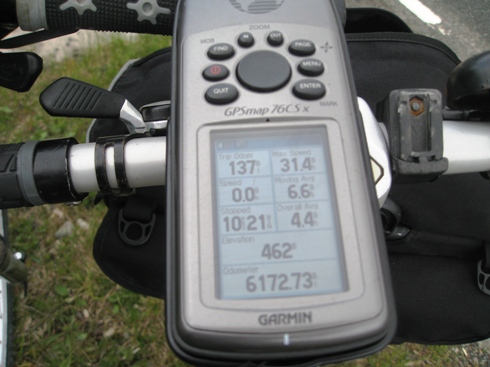
The GPS on the handlebars showing the cycle computer screen
